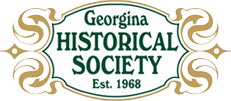Click to Download the PDF
Download the Word Doc
President’s Message
Welcome to the Georgina Historical Society’s October 2020 newsletter! Unfortunately due to the increased restrictions on the number of people allowed to attend meetings caused by Covid 19 case increases, we are still unable to hold General Program Meetings at this time. We will hold the AGM as soon as possible after the restrictions are relaxed and hopefully be able to return to our regular activities in the New Year. The GHS Board would like to thank all our members for their patience and support during this unprecedented time.
It will soon be time to renew your annual membership in the GHS for 2021. We appreciate all who are able to renew using the form on our updated GHS website. Please contact any Board member if you have questions or concerns about your renewal. With your support the GHS will be able to continue to preserve, protect and promote the rich history of Georgina. Thank you!
As a fund raiser the GHS is producing a 2021 calendar “Landmarks of Georgina”. It will feature photos of notable aspects of our heritage such as the Sutton Mill, Pefferlaw Dam, Baldwin Grist Mill, Mossington Bridge, Red Barn Theatre, Elmgrove School, Christ Church, St George’s Church and of course the Pioneer Village. The calendar will sell for $15 and will make a great Christmas gift. Please contact any GHS Board member to reserve your copies.
Take care! Stay safe!
Tom Glover
A Caboose in Need of Restoration – By Tom Glover
The Georgina Historical Society has undertaken to restore and refurbish the caboose at the Georgina Pioneer Village. The caboose at the Pioneer Village dates back to 1914. Originally it ran on the Toronto Hamilton and Buffalo Railway (TH&B) which was eventually taken over by the CNR and CPR. The caboose remained in CN’s possession until it was decommissioned. Gerry Verdoold purchased it and moved it to Sutton. It became a tea room and joined a dining car next to the IGA. When the IGA was sold the Verdoold family generously donated the caboose to the Georgina Historical Society to be part of the Pioneer Village.
Sitting next to the train station at the Village the caboose never reached its full potential as an attraction. Its interior was used for storage and the exterior has fallen victim to the elements of nature. The Georgina Historical Society wishes to restore and refurbish the caboose in order that it can become a focal point for the Village. The caboose was the last car on the train but certainly not the least. It was the headquarters for the conductor. From his vantage point he would watch for smoking brakes, overheated journal boxes, swaying cars, and shifting freight. The caboose contained sleeping and eating space as well as office and storage facilities. With the advent of electronic monitoring the importance of the caboose declined and by the 1980s they were redundant.
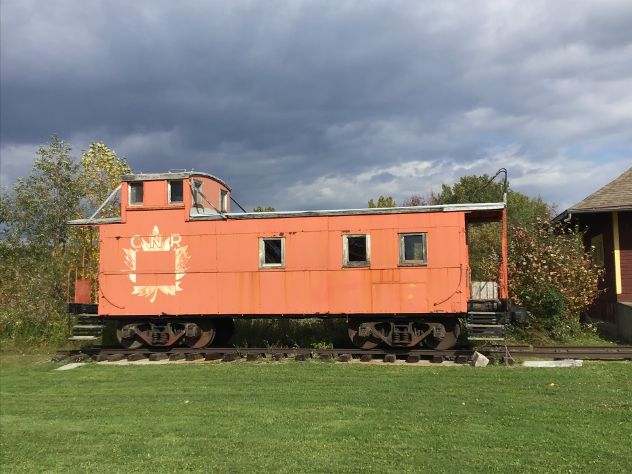

RESTORING THE CABOOSE
- Repair Roof
- Replace windows
- Exterior clean, repair, repaint
- Accessible entrance and exit
- Walls, floor, trim
- Refurnish interior appropriately
DONATIONS – We welcome all donations. For donations over20 dollars the Georgina Historical Society will issue a Charitable Tax Receipt.
SPONSORSHIPS – We are seeking sponsors from community organizations and businesses. We appreciate your support for the caboose restoration project.
CONTACT
Tom Glover, President Georgina Historical Society
E-mail: georginahistoricalsociety@outlook.com
Mobile: 905.830.2575
Home: 905.722.0180
Where in Georgina?
Dale Taylor correctly identified our June mystery picture as Carolyn Lodge, also known as Clarlyn Lodge, at Old Homestead Road and Lake Drive. Today we know it as the Orchard Beach Lakefront Bar and Grill. Can you identify where this month’s picture is located?

The Rattlesnake
That time the Pirate Ship came to Jackson’s Point
By Paul Brady

February 22, 1984 was an exciting day for our little town. The pirate ship “Rattlesnake” was being loaded on a flatbed trailer to begin its three hour trip from Rama to Jackson’s Point. The boat was the creation of artist and wood carver David May. At eighty two feet long and weighing in at thirty tons, it was an incredible example of what a person can accomplish. It was a two/thirds scale model of a 1780’s pirate ship that had plundered the Atlantic.
Mr. May had been looking for a place to complete his project and the Town of Georgina was looking for something to energize the lagging tourist trade in Jackson’s Point. A Tourist Industry Consultant from Orillia had been working with the May’s and she thought of the Town of Georgina. She put the two parties together and a deal was done. Everyone was excited by the prospect of this magnificent creation being completed on Bonnie Park. A site was prepared about a hundred metres back from the beach, right next to the fence on the southern edge of the park.
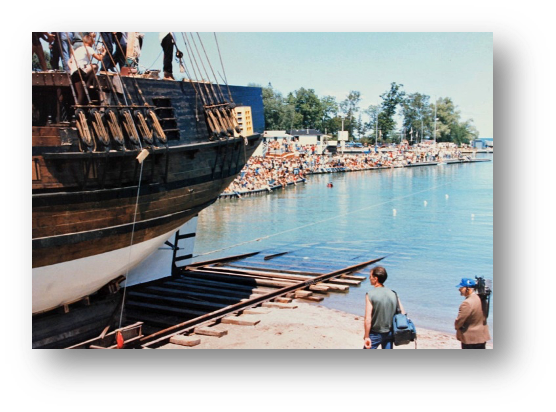
It was the perfect place as the “Rattlesnake” was also the home of the May family. This location gave the May’s access to the washroom in the park, and allowed them to use the building as the workshop.
Over the next year and a half the May’s worked away. The deal was working out for both parties. The boat was coming together nicely with the owners greeting all visitors with warmth and respect. Grants were flowing in to hire people to help with the build, corporate sponsors such as Minwax were contributing goods, Toronto media were doing interviews from and about the “Rattlesnake”, and the forgotten skill of planking a hull was an unexpected topic of conversation.
It was a pretty exciting period, with carloads of curious tourists on the weekends and local sidewalk inspectors doing a daily drive-by inspection. My wife Kim and I weren’t living at the Point at that time, but we made a special trip up to see the boat. Mr. May was charming and showed us around, taking time away from his work to be very accommodating. He had almost taken on a pirate’s aura, with his full beard and bold demeanor. Even the most ardent of critics were having trouble finding something to complain about.
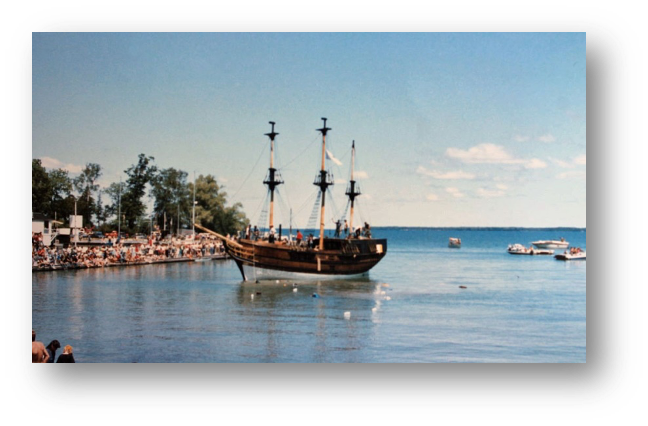
February 20, 1985 was an exciting day. The 3, 34 foot long, 600 pound masts were ready to be “stepped”. A local sign company arrived with their crane and the masts were set upright and slipped into place. We suddenly had a real pirate ship! Four months later, June 26, 1985, was the big day. It was a perfect early summer day, clear blue skies, warm, and the lake was calm and clear.
The crowds were huge, reported to be from 500 (low) to as many as 2,000 (probably more accurate). The shore and docks were lined with people, Bonnie Park was crowded, and several boats bobbed out in the harbour. The Town had excavated a section of the beach and had set up a temporary marine railway. Podiums were erected, a folk group entertained and it was the most excitement Bonnie Park had seen in decades. Mr. May’s lifetime dream was ready for her debut, and with a sounding of “All Clear!!” she slipped easily into the water and bobbed gently in the calm water, her water line perfectly level and several inches out of the water. Perfect.

Over the next couple of months the “Rattlesnake” was moored to the town dock and her shakedown runs were all trouble free, more or less. She moored up along the Jackson’s Point dock, still creating interest and traffic.
As the July 1, 1986 celebrations approached things were readied for cruises of the Lake. “Rattlesnake” played a big part of the celebrations. All went well, the ship performed well and impressed all who saw her, or were lucky enough to get a ride.
And then she was gone. That night the rigging was dismantled, the masts were taken down and she was halfway down the Trent before Georgina officials were made aware of her departure. With a contract in hand that had been signed in the spring guaranteeing three years of service to the Town, they had the flight stopped by court injunction in the Trent system. This was relinquished shortly thereafter as the boat was impeding traffic in the canal, and she was allowed to carry on to the Toronto Harbour.
The Town was understandably outraged, demanding that the boat return and fulfill its obligations. A $20,000 loan from the Jackson’s Point B.I.A. was repaid but other than that no other resolution was reached, as far as I know. The ownership of the “Rattlesnake” had changed to a numbered company and the boat, reportedly valued at $1,700,000 in 1986 dollars, fell off my radar. It was rumoured to be seen in Florida or along the shore of Lake Ontario, but its final fate is unknown to me.
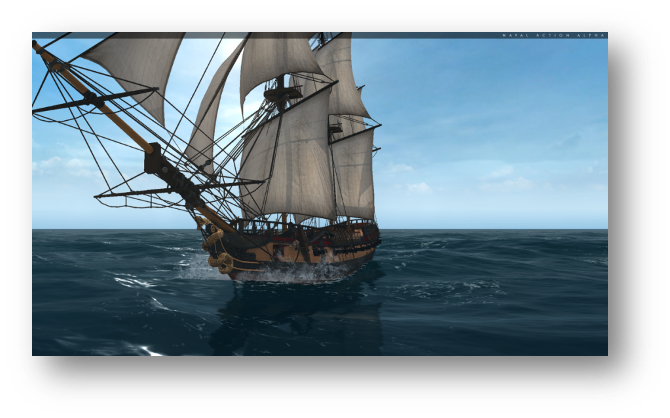
This story was compiled with the aid of the Keswick library and their wonderful collection of Georgina Advocate back issues, and my own recollections. I had a tour of the boat early on and was present at the launch, but that was the extent of my involvement. If you have anything to add to this story, I would love to hear from you. – Paul Brady, March 24, 2019. Originally published in the Georgina Post in April, 2019.
Editor’s note: –
The Rattlesnake in now in Jacksonville Florida at The Maritime Heritage Foundation, the sponsor of a Sea Explorer Chapter of the Boy Scouts of America aboard the replica vessel. The Foundation is currently planning expansion of its existing programs to include a sailing school, navigation, oceanography, and marine science programs while emphasizing the importance of environmental stewardship in a maritime environment. The Rattlesnake is currently moored in the St. Johns River of Jacksonville, which provides an on sight location to enhance its programs.
The Revolutionary War privateer RATTLESNAKE was designed in 1779-80 by John Peck, a Boston naval architect. The original RATTLESNAKE was originally built in Plymouth Massachusetts, and in style resembled a miniature frigate, which had a separate quarter deck and forecastle. She was very lightly built and was reputedly very fast. These features are rather unusual for a privateer. She carried up to 20 guns, (Probably six and nine pounders) and had a usual complement of 85 men. Launched in 1780 at Plymouth, Massachusetts, she was commissioned on 12 June 1781 under Commander Mark Clark (or Clarke) as the Massachusetts privateer Rattlesnake.
Little is known of her career except that it was brief. Shortly after her commissioning, she was captured by the British frigate ASSURANCE (44 guns, Captain James Cumming) on the 17th of June. She was sent into New York, arriving on the 8th of July and was purchased into the Royal Navy on the 28th. On November 30, 1781 she was re-registered CORMORANT (the Royal Navy already had a RATTLESNAKE) and sailed under Captain John Melcombe’s command carrying to England the first news of General Cornwallis’s defeat at Yorktown in the American Revolution. She went on to serve in the Royal Navy as the CORMORANT until re-commissioned as the CORMORANT RATTLESNAKE in 1783. She subsequently served in the waters off Britain, Western Europe, and in the Mediterranean. In July 1786 she was deemed surplus to navy requirements, and was paid off, then sold on October 10th of that year. The vessel was considered unusually fast, and her hull lines were recorded by the British Admiralty after capture and have come down to us today.
Editor’s sources for the above: https://www.streport.com/files/rsnake1.htm; Wikipedia; images from Google
Jackson’s Point – Ontario’s First Cottage Country – By Bob Holden
Well into the 19th century transportation in and out of the Townships of North Gwillimbury and Georgina was difficult at most times and only slightly better in dry weather or when the ground was frozen in winter. From middle of that century until the rails arrived in Sutton in October 1877, the movement of freight and people were confined to the Northern Railway and a steamboat from ports on the west side of the lake or by wagons and stagecoaches over poor, bone-rattling, rough, rutted, and often mucky roads. Until rails arrived into that part of York County bordering the south shores of Lake Simcoe, Jackson’s Point remained a sleepy steamboat port and was mainly a place to receive people and goods from points better served by good roads and railway links.
October of 1877 forever changed this. The narrow gauge Lake Simcoe Junction Railway had arrived. From that time on the movement of freight and people became much easier. Suddenly the southern shores became readily accessible for recreation and Ontario’s first cottage country was born. That was not all; the village also became a focus for the shipping of timbers and ice to hungry markets in the south. The railway began to promote excursions to Lake Simcoe and teamed up with or owned steamboats to bring people onto the lake for holidays and recreational activities. Other entrepreneurs built hotels, guesthouses and dance pavilions to accommodate those coming to enjoy the waters and beaches of the south shore of the lake. Many also booked connections onto steamboat excursions for other destinations on the lake.
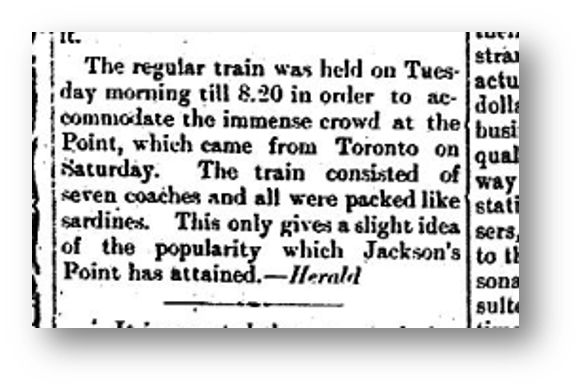
Left – From the Newmarket Era August 19, 1898
The clipping on the left from the Newmarket Era bears mute witness to the fact that by the end of the 19th century Ontario’s original “cottage country” was firmly established. The “Point” had become a mecca for tourists with hotels, dance pavilions, cottages and picnic grounds that were readily accessible by boats, trains, and in 1907, by trolley.
Accommodations could be had for as little as $1 a day in hotels like the Glen Woodland, Kenwood, the Lakeview House and Jackson’s Point Hotel scattered about “the Point”. Refreshments and a quick smoke after your meals could be had with a 5 cent cola or cigar, though stronger fare was also readily available in the only licenced establishment; the Jackson’s Point Hotel. Latest fashions and clothing designs could be purchased from milliners and dressmakers on Sutton’s High Street.
Right – Crowds in front of the Jackson’s Point Hotel in 1911.

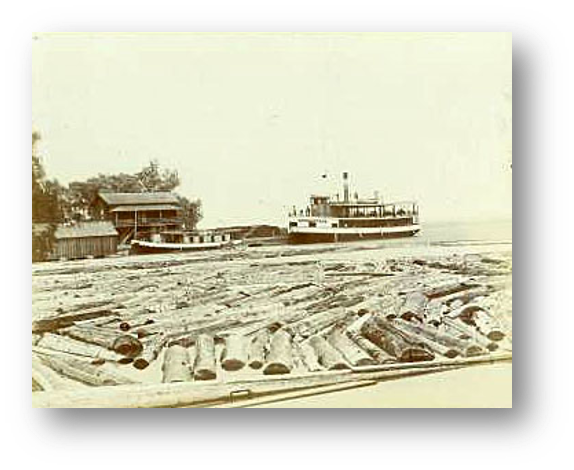
Left – the Enterprise owned and operated by the Lake Simcoe Junction Railway at the Jackson’s Point wharf ca. 1900
Visitors such as Prime Minister Wilfred Laurier visited in 1908; crowds in the thousands attended the famous Herb Lennox Picnics in the park or came for a leisurely excursion about Lake Simcoe; others arrived for the Sutton Fair or the annual Lake Simcoe Regatta.
Right – The hub of many events was the Jackson’s Point Hotel.
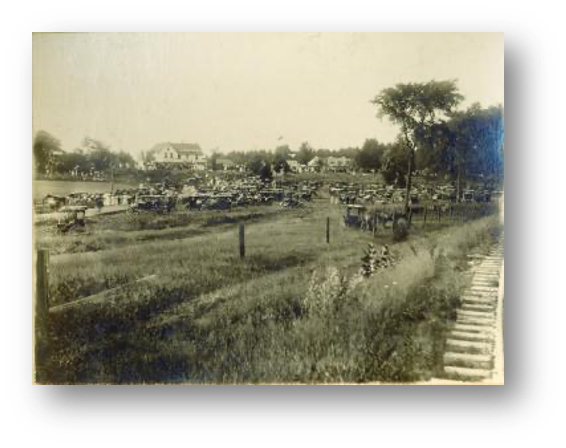
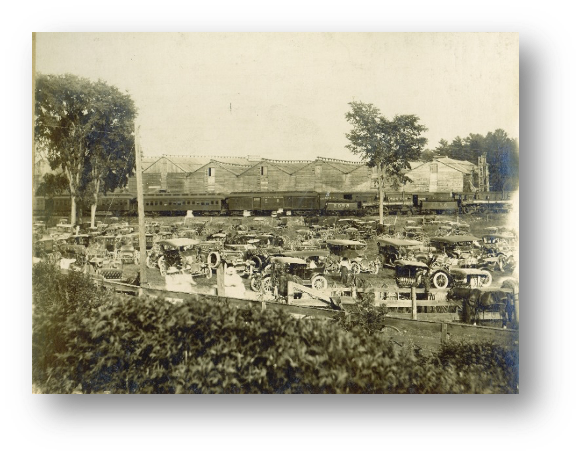
Left – Crowd in front of the trains and ices houses ca. 1911
When the Toronto & York radial railway arrived in 1907, getting to the “Point” became quicker and easier. With a summer schedule of seven cars per day much custom was lost by the older and slower Lake Simcoe Junction line, at this time part of the Grand Trunk System.
Right – Jackson’s Point radial station. ca. 1910
From the railway stations it was easy for passengers to arrange a ride to their accommodation of choice or travel onwards to board a steamboat for other destinations around the lake.

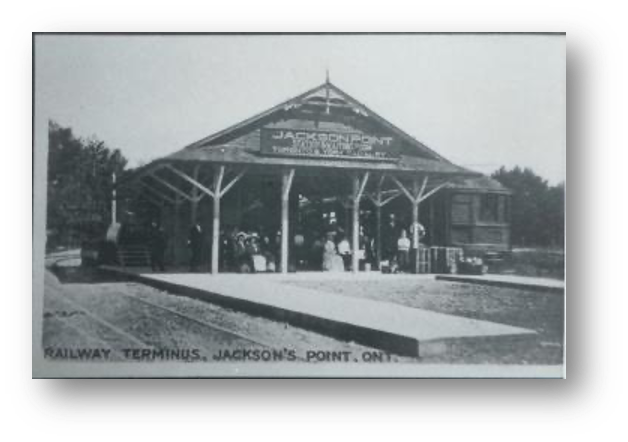
Left – the Trolleyrest (now the Simcoe Arms) at Jackson’s Point in 1909.
The http://www.virtualmuseum.ca, Community Stories in Waiting for the Radial in Georgina sums up the pre-war prosperity and popularity of the ‘Point’… “The big Lennox picnic, and they came by every mode of transportation and I’m sure they came up from the city by the Radial and it was the way to come up here. And a lot of hotels and they were full in the summertime and dancehalls, there were a lot of dancehalls and they were full, dancing in the summertime, and, of course, from here they could get on the boats and go around the lake. I think it was the time of tourism here.”
Right – Jackson’s Point Grand Trunk station in 1910
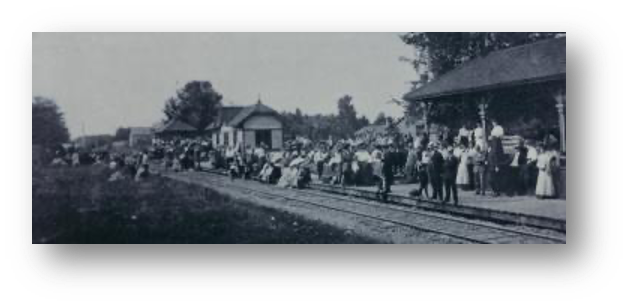
After the first war, motor vehicles and better roads appeared making access to more remote destinations possible. By the end of the Second World War, transportation technology had advanced so much that the tourist trade declined to destinations such as Jackson’s Point. By then the radial was gone, their services replaced by buses and automobiles, and the CNR had absorbed the Grand Trunk, abandoning most passenger services on smaller branch lines. Later, it too would follow the radial into abandonment. Today only a few of those many establishments from Jackson’s Point’s heyday remain for us to enjoy, not yet the victims of ‘progress’.
Editor’s note: Many photos and resources came from:
http://www.virtualmuseum.ca/sgc-cms/histoires_de_chez_nous community_stories/pm_v2.php?id=record_detail&fl=0&lg=English&ex=00000624&hs=0&rd=147434; “Canada 150 prompts look back at Jackson’s Point tourist mecca” by Heidi Riedner, Georgina Advocate, Tuesday June 20, 2017; and from the digital files of the author.
Social distancing at your Board’s October meeting in the Village:
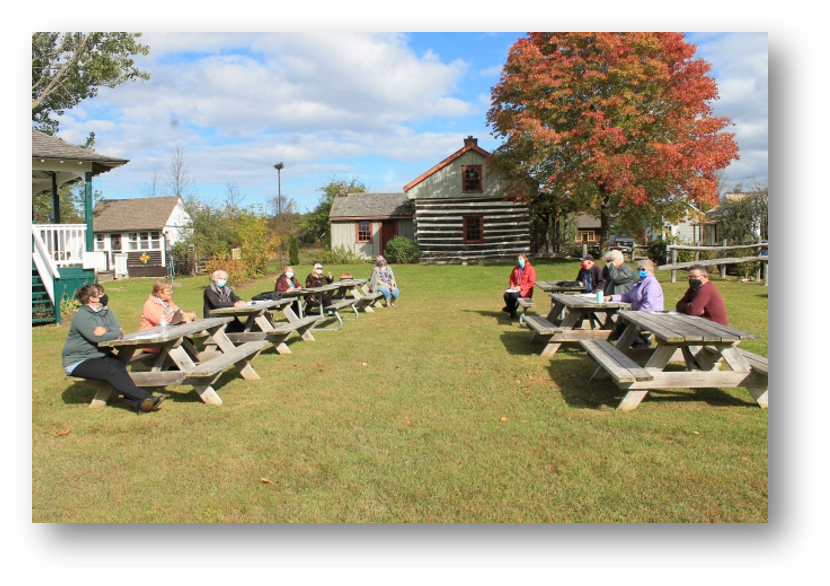
News and Events
Georgina’s Pioneer Village and Archives curator, Melissa Matt, has been busy developing stories about the buildings in the Village, and the exhibits that can be created and displayed once it is open to visitors again. She has also been working to develop other formats to tell the Village’s story and to prepare for eventual digitization once the appropriate software is purchased.
At the October Board meeting, it was announced that the application to the Museum Assistance Program Grant for funds was successful and that this money has been earmarked to cover costs of several Pioneer Village initiatives such as display cases, school packages, and virtual outreach projects (identified as needs due to the ongoing pandemic). Software introduced in the last Board meeting was found unsuited for our needs. A search will continue for software digitization of archival resources. Two Students continue to work on a part-time basis in the Village and there is a distinct possibility that their work period may be extended for a little longer.
Shingling is now completed on the roofs of both the Mann House and the Noble House. The work of building a new porch/deck on the Mann house is almost complete, and a few columns have been added. The Town plans to go back to the Council on October 28 to get some direction for the next steps regarding how to move forward with restoration of the schoolhouse. The Town of Georgina Roads Department is scheduled to begin digging out a ditch in November to help with water drainage issues in the village and surrounding areas.
Tom Glover reported that General Meetings will continue to be on hold until at least the beginning of 2021 due to the pandemic.
Currently, the new restrictions it impossible to have 40 – 50 people in attendance at for our Annual General Meeting; public health and government guidelines have changed. We will revisit this situation at the next Board meeting. Legally the GHS must have an AGM within 15 months of the last one, which was in November 2019. We will keep you posted on the status of the AGM.
Interior paneling in the caboose has been removed and disposed of, and the wall framing is now exposed. A five-page information package has been created and distributed entitled “A Caboose in Need of Restoration” (see Tom Glover’s article elsewhere), complete with photos of the exterior and interior of the caboose, its history, the steps required to restore the caboose, and an appeal for donations and community sponsors to help us achieve this goal. Charitable receipts will be given for any contributions to this restoration fundraiser. Tom is waiting to hear back about the Hodge Grant which could be applied to the Caboose Fund. We have received this grant in the past and are hopeful we will receive it again.
Tom Glover proposed another fundraising initiative to publish a calendar for the 2021 year. He has chosen the photographs already to accompany each month and hopes to be able to have it ready for sale by the end of October, in time for people to consider purchasing as Christmas gifts. Each photo is representative of a significant aspect of Georgina’s heritage.
Karen Wolfe updated the Pefferlaw Dam and Johnston Cemetery concerns saying that both issues will be up for discussion on the Heritage Advisory Committee meeting agenda later this month (Oct. 21). Sarah Harrison noted that we need copyright permission from York Media in order to digitize Sutton newspapers and make them searchable. Previous attempts have not been fruitful, but there are new owners now, and she will try once again. Also, the GHS may be eligible for a grant from the Virtual Museum of Canada which will help us to tell community stories (would make it possible to hire a service like “My Digital World”).
NEXT BOARD MEETING: Monday, November 2, 2020 at 2:00 p.m. Location TBA.
All general meetings and events other than our Board meetings are currently suspended until further notice. Your Board and the GHS committees will still be actively engaged in carrying out our mandate despite difficult circumstances resulting from the Covid pandemic.
Help us!!
It was mentioned that we should be collecting a record of activities and events during this pandemic for our Archives. Accordingly, we would love it if members and readers of this newsletter would share with us any copies of images and anecdotes showing how the pandemic has affected us and changed our lives during this very trying time. Send them to Tom Glover or Bob Holden c/o the Georgina Historical Society address or e-mail on the Contact Us page.
